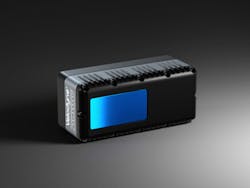Velodyne and Hyundai Mobis to Develop LiDAR-Based ADAS System
Velodyne Lidar has reached an agreement with Tier-1 automotive component supplier Hyundai Mobis to launch a new advanced driver-assistance system (ADAS) that integrates Velodyne Velarray Lidar technology and Hyundai Mobis cognitive software. Hyundai Mobis will also invest $50 million in Velodyne, creating a synergy between the two companies to reinforce business cooperation in LiDAR commercialization.
Velodyne Velarray equips vehicles with scalable ADAS functionality (levels 2 to 4 of the Society of Automotive Engineers [SAE] levels of driving automation). It uses a series of lasers to accurately measure distances in the environment at the speed of light for road safety. This includes the detection and avoidance of pedestrians and bicycles, lane maintenance, automatic emergency braking, adaptive cruise control, and blind-spot detection, as well as advanced autonomous navigation functionality.
Specifically designed for ADAS in consumer vehicles, Velarray offers a compact form (see figure) that can be placed within a vehicle’s body or behind the windshield, maintaining the vehicle’s aerodynamic design. It produces a high-definition, three-dimensional directional image, day or night, providing cars with a more detailed view of their surroundings to maximize roadway safety. Velarray detects areas with a horizontal angle of 120 degrees, a vertical angle of approximately 35 degrees, and a range of up to 200 meters, allowing for faster object identification and longer braking distance at highway speeds. Mass production is slated for 2020.
Velarray’s compact form enables it to be placed within a vehicle’s body or behind the windshield. (Source: Velodyne)
Hyundai Mobis will develop and integrate its own cognitive software for the combined system. This software will process the outside vehicle environment data gathered by LiDAR sensors, which means that it would recognize and analyze moving or stationary objects, along with road systems such as traffic sign information.
"Working with Hyundai Mobis and our valuable global partners, we will introduce the power of Velodyne's 3D LiDAR perception in vehicles to improve automated safety for consumers around the world," said David Hall, founder and CEO of Velodyne. "We believe that powerful ADAS systems can be the springboard for building public confidence and a path to total autonomy."
Since its first commercial launch of products in 2010, Velodyne has shipped more than 30,000 units and generated cumulative sales of more than USD$500 million.
The new LiDAR system will complement the camera and radar technologies developed by Hyundai Mobis, allowing the company to offer a portfolio of detection technologies for ADAS applications. As an in-house project, Hyundai successfully developed a short-range radar last year and plans to offer a deep-learning-based camera and high-performance radar technology by next year.
In July last year, Hyundai Mobis developed a customized steering system for autonomous vehicles, ensuring that normal steering is feasible in any circumstance—even when the steering system faces an unexpected problem while the vehicle is being driven. Last month, Hyundai Mobis also announced development of a new redundancy brake system optimized for fully autonomous driving (level 4 or higher).
Since autonomous driving cars must be able to handle emergency situations by themselves at levels 4 and 5, Hyundai’s emergency brake system is activated automatically when the brakes don’t work normally due to failure of electrical devices or external shock. The redundancy brake system consists of two electronic systems, an ECU, and a software control platform. In normal operation, the two controllers are connected to each other and exchange data. However, if the main brake system isn’t working normally, the controller detects it and orders the auxiliary brake system to engage.
Hyundai Mobis and Velodyne plan to commercialize their first LiDAR system for level 3 autonomous driving in 2021 via this partnership. The two companies will first supply the system to the Asian market and then gradually expand to automakers in North America and Europe.


